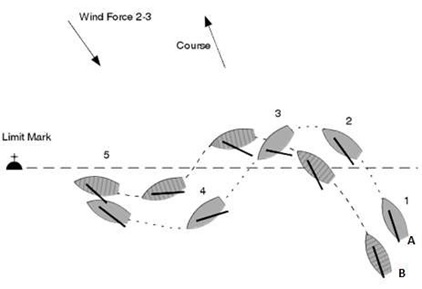



CASE 13
Definitions, Proper Course
Rule 11, On the Same Tack, Overlapped
Rule 14, Avoiding Contact
Rule 15, Acquiring Right of Way
Rule 16.1, Changing Course
Rule 17, On the Same Tack; Proper Course
Rule 43, Exoneration
Before her starting signal, a leeward boat does not break a
rule by sailing a course higher than the windward boat’s
course.

Facts
As the two 14-foot (4 m) dinghies, A and B, manoeuvred before the starting
signal, they crossed the starting line. While bearing away to return to the
pre-start side, A, initially the windward boat, assumed a leeward position by
sailing under B’s stern. Immediately after position 4, A luffed to closehauled
and sailed straight for the port end of the line. B meanwhile, with
sheets eased, sailed along the line more slowly. At position 5, there was
contact, B’s boom touching A’s windward shroud. A protested B under rule
11; B counter-protested under rules 12 and 15.
The protest committee found that A had right of way under rule 11 from the
time she assumed a steady course until contact. B had room to keep clear,
although she would have had to cross the starting line prematurely to do so.
Therefore, it dismissed B’s protest and upheld the protest by A. B appealed,
this time citing rule 16.1.
Decision
B’s appeal is dismissed. Between positions 2 and 3 A became overlapped to
leeward of B, acquiring right of way under rule 11 but limited by rule 15’s
requirement to initially give room to B to keep clear. A met that requirement
because A gave B room to keep clear. Just after position 4, when A luffed
to a close-hauled course, she was required by rule 16.1 to give B room to
keep clear, and she did so.
A had been clear astern of B and was within two of her hull lengths of B
when she became overlapped to leeward of B. Therefore, she was required
by rule 17 to sail no higher than her proper course. However, she had no
proper course before the starting signal (see the definition Proper Course)
and the starting signal was not made until after the incident. Therefore, A’s
luff did not break rule 17 and she was in fact entitled to luff higher than she
did, even as high as head to wind, as long as while so doing she complied
with rule 16.1.
After A became overlapped to leeward of B, B was required by rule 11 to
keep clear of A. She did not do so and accordingly her disqualification under
rule 11 is upheld. In addition, B broke rule 14 because she could have
avoided the contact with A; and as she was not sailing within the room to
which she was entitled under rule 16.1, she was not exonerated by rule
43.1(c).
A also broke rule 14 because it would have been easy for her to bear off
slightly and avoid the contact. However, she was exonerated by rule 43.1(c)
because she was the right-of-way boat and there was no damage or injury.
GBR 1965/10






